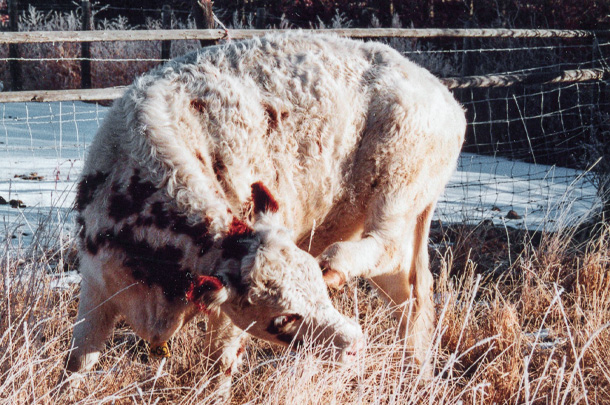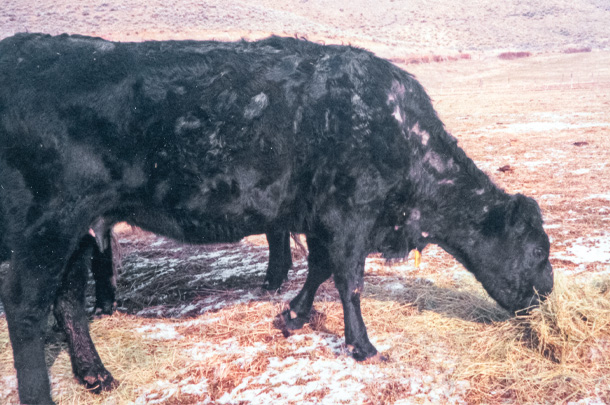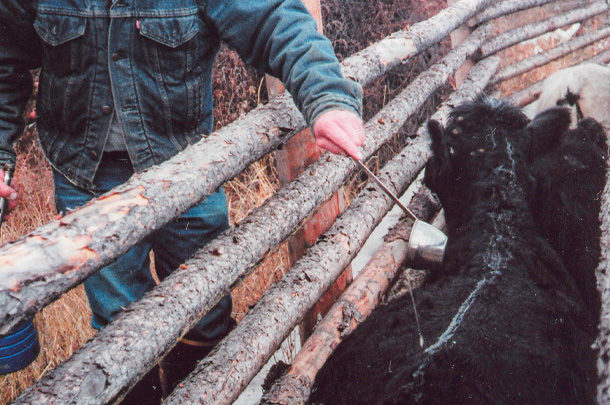Lice are a common winter problem in cattle, especially in northern climates with cold weather and short winter days.Summer heat, sunlight and short hair make it more difficult for lice to survive and multiply; their numbers increase dramatically when weather is cold and cattle have long winter hair for lice to hide in.
Dr. Gerald Stokka, an extension veterinarian and livestock stewardship specialist with North Dakota State University, says there are two types of lice, sucking lice and biting lice, and a number of species within each type.
“Sucking lice are easier to control because they suck blood and [are] vulnerable to systemic treatment, such as avermectin products,” he explains.
Julie Walker, a beef specialist at South Dakota State University, says lice are usually found along the back and topline, and if an animal has lice there’s usually hair rubbed off because of continual itching.

Observing cattle to see their rubbing and itching is a key to treatment. Don’t be afraid to re-treat in later winter months. Photo by Heather Smith Thomas.
“Generally, we don’t notice that a cow has lice until we see the rubbing and patches of hair rubbed off. Lice are transferred from one animal to another by direct contact; when animals are brought into close proximity, opportunity for transfer is higher,” she says. This can happen when cattle are brought into corrals for processing or confined for winter feeding. In a feedlot, a pen of “clean” cattle may become infested by nose-to-nose contact with lousy cattle in the adjacent pen.
Elements of control
“Pour-on products are a popular control method due to ease of application and reduced stress, compared to spraying in cold weather,” says Walker. “With a pour-on you can give each animal proper dose for size/bodyweight, and every animal gets treated. Follow label directions and adjust dose, based on size. You can also use dust bags in a gateway the cattle have to go through.”
Depending on species, a female louse lays one to four eggs per day, attached to hairs. “Adult lice live about 35 days. Eggs incubate four to 15 days and then hatch. The time from egg hatch to adults is about three to four weeks. You must kill newly hatched lice as well as adults to eliminate lice,” she says.
Timing of control is important. If you treat too early, surviving lice multiply; wait too long and cattle lose performance due to heavy lice infestation. For producers in northern states, Walker recommends treating in October or November. You don’t want lice to have time to rebuild high populations, which would require retreatment in mid-winter, when cattle can least afford the drain on their energy and are rubbing their hair out when it’s sub-zero.
Cattle need adequate nutrition through winter. Lice tend to multiply more quickly on animals lacking in nutrients (with weaker immune systems). Cattle with higher nutrition levels (enough for maintenance, growth, pregnancy and keeping warm) generally have lower louse populations and are less severely affected by lice. If animals are cold and losing weight, they have less resistance to lice than well-fed animals.

Many producers don’t know cattle have lice until patches of hair have rubbed off. Photos by Heather Smith Thomas.
Depending on how cold and long your winter is, you might want to re-treat for lice in January if cattle are itching and miserable. If you’ll have an early spring, however, lice will become a nonissue. With more hours of sunshine and warmer temperatures, lice populations begin a natural decline.
Why treatments sometimes fail
David Boxler, entomology extension educator with the University of Nebraska, says lice control often fails simply because producers treat too early, before lice numbers increase. “In our area, we generally wean in late September or early October, so ranchers use that opportunity to vaccinate and control internal parasites, grubs and lice,” he says.
Lice populations are still low at that time, however; you might be wasting money to treat this early. As an example of how temperature affects lice populations, Boxler says that when ambient temperature is 78ºF, the animal’s skin in full sun can reach 100ºF. “This inhibits lice, eggs and egg production, and when skin temperature exceeds 100 degrees, some die. At 125 degrees, all species of lice die within an hour.”
There are always a few lice that survive on cattle through summer, but most of them die or do not reproduce. “They go into a stage of estivation. They are still there, but dormant, not feeding or reproducing. As temperatures drop, populations increase,” says Boxler. This is a cold-weather insect.
If cattle are out on fall/winter pastures in late November through December, the rancher may not want to bring them in again just to treat for lice, since this adds another stress. It might be better to wait and treat for lice when giving pre-calving vaccinations later in the winter.
“If daytime temperatures are still in the 50s and 60s, it’s too early. In our area, I suggest looking at cattle in late December to check for lice. Bring a few in and restrain them in a chute so you can part the hair and look for lice. I use a halogen light and magnifying glass, especially with dark-colored cattle. Chewing lice are hard to see in dark hair. Sucking lice are a bit easier to see because they have bluish color and are not moving around and hiding in the hair,” says Boxler.
“Chewing lice are more active and their populations can increase dramatically because they can reproduce asexually; the females don’t need the male. We often see huge explosion of that species in a short time.” This may be another reason some herds have more problems with chewing lice than sucking lice, because their numbers increase so quickly.
A few individuals in the herd may have more lice; they carry more lice through summer and lice populations increase on them more dramatically in fall and winter. “We suggest culling those carriers,” says Boxler. Otherwise, they spread lice to the others after they’ve been treated. This susceptibility to lice may be partly genetic. You might not want to keep daughters from that cow (or bull).
When applying products for lice, read labels and follow directions – and never underdose. “Some people get in a hurry and do animals in an alley, and there is product flying everywhere,” says Boxler. Some may not get onto the animal or may all be applied in one area along the back rather than a complete line from nose to tail.
Another reason for treatment failure is that some products only give good control on sucking lice but not chewing lice. Non-systemic products are synthetic pyrethroids. Most products require two applications 14 days apart to get newly hatched lice, since these products don’t kill eggs. There is one product that contains a combination of a synthetic pyrethroid and an insect growth regulator, which will affect the eggs. Boxler says this is a good “rescue” product if other treatments have failed.
Producers have used ivermectin for many years – injectables and pour-ons – and have gotten good lice control. “But most parasites, weeds or bacteria develop ways to evade control measures,” says Stokka. “Now, due to improper dosing or natural resistance, some lice have become less vulnerable to avermectin products,” he says.
“These are products we probably should not have used for lice in the first place, and probably not pour-ons because absorption is highly variable depending on dirt, moisture, hide thickness, hair follicles, etc. The injectable is more predictable because you are putting the drug under the skin where it is absorbed, if you use the right dose,” he says. However, injectable products do not control biting lice.
Underdosing probably helped lead to treatment failures. “Producers assumed they still had 1,100- to 1,200-pound cows, while in reality they had 1,500- and 1,600-pound cows,” says Stokka.
“The second thing we did wrong was treating too early in the season. Lice are relatively inactive in warm weather, especially the biting lice. You can’t control them because they need to have physical contact with the product. If they are not moving around, this won’t happen,” says Stokka.
“My recommendation is to not treat for lice until you actually see a problem, in cold weather and heightened lice activity; treatment will be more successful. I also tell people to not use avermectins at all for lice. Options are limited, however. We are down to two kinds of products – avermectins and pyrethrins.”







